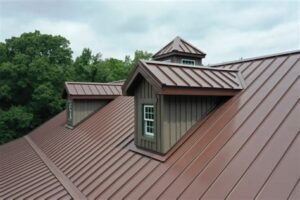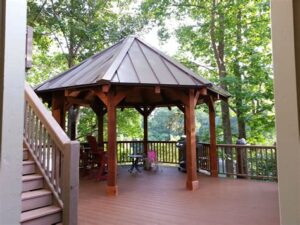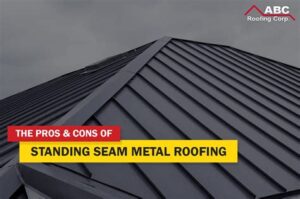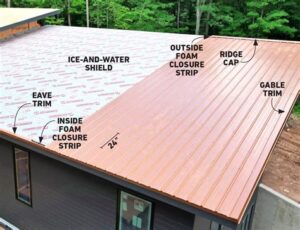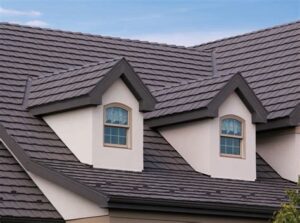When it comes to protecting your home, the roof plays a crucial role, and choosing the right features can significantly enhance its durability. Metal roofs are renowned for their longevity and resilience, but without proper flashing, they can be vulnerable to water damage and leaks. In this article, we delve into the essential role of flashing in metal roofing, exploring its benefits, how it impacts water drainage, and identifying signs that your home may need flashing installation. We assess whether the investment in flashing is worth it for your metal roof and provide answers to common questions that homeowners have. Let’s uncover why flashing could be the key to ensuring your metal roof serves you well for years to come.
Understanding What Flashing Is For Metal Roofs
Flashing is a critical component in roofing systems, particularly for metal roofs, as it helps protect vulnerable areas from water damage. It is made from various materials, including aluminum, copper, and galvanized steel, designed to divert water away from seams, joints, and transitions in the roofing structure.
In essence, flashing acts as a barrier, preventing moisture from infiltrating the roof and causing foundational issues or leaks. It is typically installed around chimneys, vents, skylights, and the edges of the roof where it meets walls to create a watertight seal.
There are several types of flashing used in metal roofs, including:
- Continuous flashing: Long strips of metal that provide a seamless transition from the roof to walls or other intersecting surfaces.
- Step flashing: Installed in overlapping layers, often used to protect the areas where a roof meets a vertical surface.
- Counter flashing: Installed over other flashing types to reinforce protection and is commonly seen around chimneys.
Properly installed flashing is pivotal for the longevity and effectiveness of a metal roof, playing a significant role in overall water drainage and leak prevention. Without it, even high-quality metal roofing can suffer from premature wear and structural issues.
Advantages of Flashing for Metal Roof Longevity
The choice to install flashing is a significant one when it comes to the longevity of your metal roof. Is flashing truly beneficial? The answer is a resounding yes. Here are some of the key advantages:
- Prevents Rust and Corrosion: Metal roofs are susceptible to rust and corrosion over time. Flashing acts as a protective barrier, shielding vulnerable areas from the elements, thus prolonging the roof’s lifespan.
- Enhances Structural Integrity: By effectively managing water drainage, flashing helps maintain the structural integrity of the roof. This prevents water pooling and reduces the likelihood of sagging and other related issues.
- Cost Savings on Repairs: Investing in flashing can save homeowners from costly repairs down the line. It minimizes the risk of leaks and damage, which could otherwise necessitate extensive and expensive repairs.
- Increases Property Value: A well-maintained roof that includes flashing is often more attractive to potential buyers, thereby enhancing the overall value of the property.
- Improved Aesthetic Appeal: Flashing contributes to a polished and completed look of the roof, complementing the overall architecture and enhancing curb appeal.
Choosing to install flashing is an investment in the longevity and durability of your metal roof. The numerous benefits it offers significantly outweigh the initial costs, making it an essential component for any homeowner looking to protect their property.
How Flashing Affects Water Drainage and Leak Prevention
Proper installation of flashing is crucial for maintaining the integrity of your metal roof. Is flashing simply a method of creating a barrier that helps manage water flow and directs it away from critical areas of your roof, such as seams and joints.
Flashing works by preventing water from seeping into vulnerable areas, thus acting as a shield against leaks. When it’s positioned correctly, it ensures that rainwater drains effectively off the roof and into the gutters. This prevents pooling and reduces the risk of corrosion, mold growth, and structural damage that can arise from prolonged water exposure.
Moreover, the material quality of the flashing plays a significant role. Using high-grade metal flashing that matches your roof can enhance durability and resistance against harsh weather conditions. This aspect reinforces your home’s defense against moisture ingress, fundamentally playing a part in keeping your roof’s warranty intact.
In conclusion, the installation of flashing is not just a decorative element. It is an essential feature that promotes longevity and effectiveness in water drainage, significantly contributing to leak prevention. Ensuring that your metal roof has proper flashing can save you from costly repairs in the long run and bolster the overall health of your roofing system.
Signs That Your Home Needs Flashing Installation
Recognizing when your home needs flashing installation can save you from costly repairs and potential damage. Here are several signs that your home may require flashing to protect your metal roof:
- Water Stains Inside Your Home: If you notice water stains on walls or ceilings, it’s a clear indication that water is penetrating your roof. This could warrant an examination for flashing issues.
- Rust or Corrosion: Inspect the metal roof for any rust or corrosion, particularly around joints or valleys. These areas are prone to leakages if flashing is absent or damaged.
- Missing or Damaged Flashing: A visual check can often reveal missing or cracked flashing. If you see gaps or any bending that looks out of place, it might be time to consider installation.
- Pooling Water: If you observe water pooling in certain areas of your roof, this can lead to leaks. Proper flashing can direct water away from these spots effectively.
- Ice Dams in Winter: If you experience ice dams during winter, it could indicate that the flashing isn’t properly redirecting melting snow and water away from the roof edges.
- Increased Energy Bills: Inadequate sealing due to poor flashing can increase heating and cooling costs. If bills seem higher without a clear reason, faulty roof flashing could be the culprit.
- Cracks in Roof Joints: Examine joints where sections of your roof meet. Worn-out joints can lead to leaks, and proper flashing can address these vulnerable areas.
If you notice any of these signs, it’s essential to consult a roofing professional. They can assess whether flashing is necessary for your metal roof, ensuring it remains protected and efficient for years to come.
Is Flashing Worth the Investment for Your Metal Roof?
When considering whether is flashing worth the investment for your metal roof, it’s essential to weigh both long-term benefits and potential costs. Flashing acts as a safeguarding element that can significantly influence the durability and effectiveness of your roofing system.
One of the primary advantages of investing in flashing is its capacity to prevent water infiltration. By directing water away from seams and joints, properly installed flashing minimizes the risk of leaks, which can lead to costly repairs and maintenance down the line. Investing in flashing can save you from the headaches associated with water damage and mold growth.
Furthermore, flashing enhances the overall structural integrity of your metal roof. A well-flashed roof can withstand harsh weather conditions, making it much more durable than one without flashing. This durability can translate into lower repair and replacement costs over the lifespan of the roof.
Here’s a quick comparison of the costs associated with having flashings versus not having them:
| Investment | With Flashing | Without Flashing |
|---|---|---|
| Initial Cost | Higher initial investment | Lower upfront cost |
| Long-term Maintenance | Lower | Higher due to leaks and repairs |
| Property Value | Increases | May decrease due to damage |
The question of whether is flashing worth the investment hinges on your priorities as a homeowner. If you value long-term sustainability and minimal maintenance, then flashing is certainly a wise investment for your metal roof. In contrast, if you are looking solely at short-term costs, you may initially be tempted to forego it, but this may lead to significant expenses in the future.
Frequently Asked Questions
What is flashing, and why is it important for a metal roof?
Flashing is a protective barrier installed at vulnerable areas of a roof, such as seams and joints, to prevent water leaks. It is crucial for a metal roof because it ensures that water does not seep under the roofing material and cause damage to the structure.
What types of flashing are commonly used for metal roofs?
Common types of flashing for metal roofs include valley flashing, chimney flashing, base flashing, and step flashing. Each type serves a specific purpose in directing water away from critical areas.
Does flashing installation require professional help?
While some homeowners may choose to install flashing themselves, it is generally recommended to hire a professional roofing contractor to ensure proper installation and effectiveness in preventing leaks.
Can improper flashing lead to significant roofing issues?
Yes, improper flashing can result in serious roofing issues, including water leaks, mold growth, and damage to the roofing structure, which can lead to costly repairs.
How often should flashing be inspected or maintained?
Flashing should be inspected at least annually and after severe weather events. Regular maintenance helps to ensure that it remains functional and effective in protecting the roof.
What materials are typically used for metal roof flashing?
Typical materials for metal roof flashing include galvanized steel, aluminum, and copper. These materials are durable and resistant to corrosion, making them ideal for long-term performance.
Are there specific considerations when flashing a metal roof in certain climates?
Yes, in areas with heavy rainfall or snow, it is essential to ensure that flashing is adequately designed and installed to handle the potential for water pooling and ice dams, which can increase the risk of leaks.
